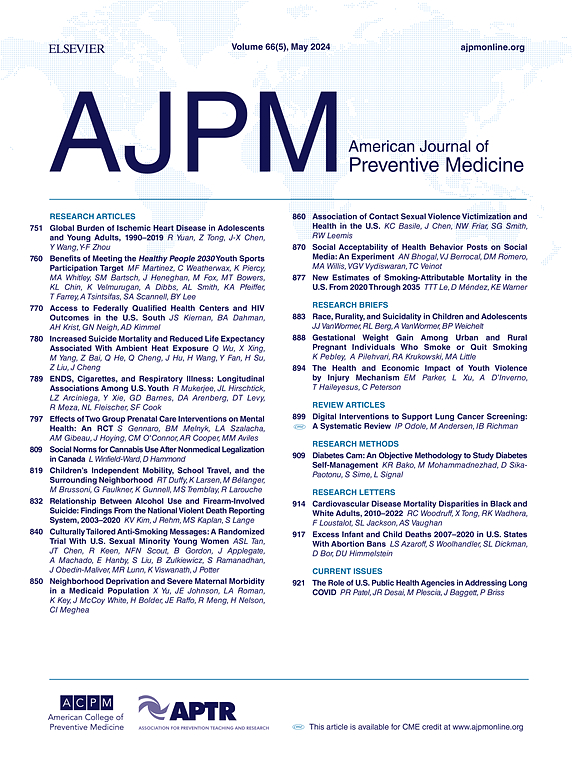Well-Being and Suicidal Ideation in U.S. Veterans: Age Cohort Effects During Military-to-Civilian Transition
IF 4.3
2区 医学
Q1 MEDICINE, GENERAL & INTERNAL
引用次数: 0
Abstract
Introduction
Life transitions often bring stress and uncertainty and may lead to poor long-term health outcomes if not navigated successfully. Every year over 200,000 U.S. service members transition from military to civilian life. Given that transition may be particularly challenging for younger individuals this study examined younger military Veterans’ well-being during transition and its impact on suicidal ideation as compared with middle-aged Veterans.
Methods
Using data from the Veterans Metrics Initiative (TVMI) study (N=6,615), latent class analysis was used to identify age-stratified subgroups of Veterans (18–34 and 35–54 years) based on health, vocational, financial, and social well-being 1 year following military discharge. Negative binomials models were used to examine associations between subgroups and suicidal ideation at 4 data points. Data were collected in 2016–2019 and analyzed in 2024.
Results
Four subgroups were identified for younger and middle-aged Veterans. For younger Veterans, subgroups included high well-being (32.3%); low well-being (24.7%); poor health and social well-being (17.3%); and poor financial well-being with health risk (25.7%). Middle-aged Veterans subgroups included high well-being with health risk (37.4%); low well-being (20.6%); poor health and social well-being (21.8%), and poor financial well-being with health risk (20.2%). Subgroups with poorer well-being had an increased rate of suicidal ideation compared with those with the highest well-being, with the strongest association with the low well-being subgroups (younger IRRs=10.1–51.0; middle-aged IRRs=11.3–26.0), followed by poor health and social well-being subgroups (younger IRRs=3.9–22.3; middle-aged IRRs=4.9–10.2).
Conclusions
Findings highlight the importance of considering age cohort effects in efforts to enhance well-being and reduce suicidal ideation among transitioning Veterans.
美国退伍军人的幸福感和自杀意念:军民过渡时期的年龄群效应。
导读:生活的转变经常带来压力和不确定性,如果不成功地引导,可能会导致不良的长期健康结果。每年有超过20万美国军人从军队转到平民生活。鉴于这种过渡对年轻人来说可能特别具有挑战性,本研究调查了年轻退伍军人在过渡期间的幸福感及其对自杀意念(SI)的影响,与中年退伍军人相比。方法:使用退伍军人指标倡议(TVMI)研究(N=6,615)的数据,采用潜类分析确定退伍军人年龄分层亚组(18-34;(35-54)退伍后一年的健康、职业、财务和社会福利。负二项模型用于在四个数据点上检查亚组与SI之间的关联。数据收集于2016-2019年,并于2024年进行分析。结果:中青年退伍军人分为4个亚组。对于年轻的退伍军人,亚组包括:高幸福感(32.3%);低幸福感(24.7%);健康和社会福利差(17.3%);财务状况不佳,有健康风险(25.7%)。中年退伍军人亚组包括:高幸福感与健康风险(37.4%);低幸福感(20.6%);健康和社会福利状况不佳(21.8%),经济状况不佳并有健康风险(20.2%)。幸福感较差的亚组与幸福感最高的亚组相比,SI率增加,与低幸福感亚组的关联最强(年轻的irs =10.1-51.0;中年irr =11.3-26.0),其次是健康状况和社会福利状况较差的亚组(年轻irr =3.9-22.3;中年irr = 4.9 - -10.2)。结论:研究结果强调了考虑年龄队列效应的重要性,以努力提高福祉和减少过渡退伍军人的SI。
本文章由计算机程序翻译,如有差异,请以英文原文为准。
求助全文
约1分钟内获得全文
求助全文
来源期刊

American Journal of Preventive Medicine
医学-公共卫生、环境卫生与职业卫生
CiteScore
8.60
自引率
1.80%
发文量
395
审稿时长
32 days
期刊介绍:
The American Journal of Preventive Medicine is the official journal of the American College of Preventive Medicine and the Association for Prevention Teaching and Research. It publishes articles in the areas of prevention research, teaching, practice and policy. Original research is published on interventions aimed at the prevention of chronic and acute disease and the promotion of individual and community health.
Of particular emphasis are papers that address the primary and secondary prevention of important clinical, behavioral and public health issues such as injury and violence, infectious disease, women''s health, smoking, sedentary behaviors and physical activity, nutrition, diabetes, obesity, and substance use disorders. Papers also address educational initiatives aimed at improving the ability of health professionals to provide effective clinical prevention and public health services. Papers on health services research pertinent to prevention and public health are also published. The journal also publishes official policy statements from the two co-sponsoring organizations, review articles, media reviews, and editorials. Finally, the journal periodically publishes supplements and special theme issues devoted to areas of current interest to the prevention community.
 求助内容:
求助内容: 应助结果提醒方式:
应助结果提醒方式:


